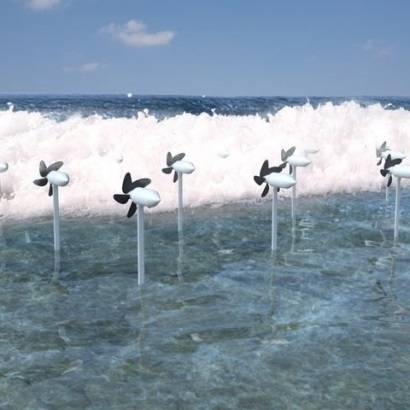
The project involves testing prototype Wave Energy Converter units in the Maldives in collaboration with the MEE and the Government of the Maldives. The Holiday Inn Resort Kandooma at South Male Atoll, Maldives, is also participating.
Professor Tsumoru Shintake, leader of the Quantum Wave Microscopy Unit, OIST, and his colleagues designed special WEC-units which can capture energy from surf waves along the shore-line and convert it into usable electricity, as part of the wave energy project which was launched in 2013.
Professor Shintake's specially-designed units are built to withstand forces from breaking waves. One of the principal features of the WEC-units is that the generating turbines are designed to be located at the mean sea level to harness the wave energy most effectively.
The experiment in the Maldives will involve installing two half-scaled WEC prototypes, with 0.35-meter diameter turbines. The prototypes will be installed about 50 meters offshore along the shoreline of the Southeastern part of Kandooma Island. The location has been selected for its low environmental and visual impact -- it is shallow with no living coral and it is situated behind a hotel, away from surfers and divers.
"The Maldives is an ideal place to test our Wave Energy Converters for three reasons," explained Professor Shintake.
Currently, there is no central power plant or way to transmit energy between the islands of the Maldives. Each inhabited island must generate its own energy supply, usually by burning fossil fuels.
In addition, the Maldives is an archipelago nation made out of atolls in which each and every island is elevated only a few meters above sea level. The islands might be influenced by the current global warming environment, and are facing a certain geophysical impact, i.e. the gradual rising of the sea level.
"The Maldives is a symbol of global climate change," said Professor Shintake.
Lastly, the location of the Maldives makes it a suitable place to harness wave energy. The Maldives receives a constant stream of waves which have propagated across the Indian Ocean from the South Pole. Unlike Okinawa, the Maldives is not a hurricane or typhoon region, so the WEC units are at low risk of damage from extreme weather conditions.
The prototype WECs are currently being shipped to the Maldives and are scheduled to be installed in April of this year. The researchers will monitor the wave energy generation from the power house on the island, as well as remotely from Japan using web cameras.
This initial trial will be followed by two full-scaled prototype models with 0.7-meter diameter turbines which will be installed in September. In the long term, the hope is to eventually diffuse full-scaled production models of wave energy convertor units throughout the Maldives.

